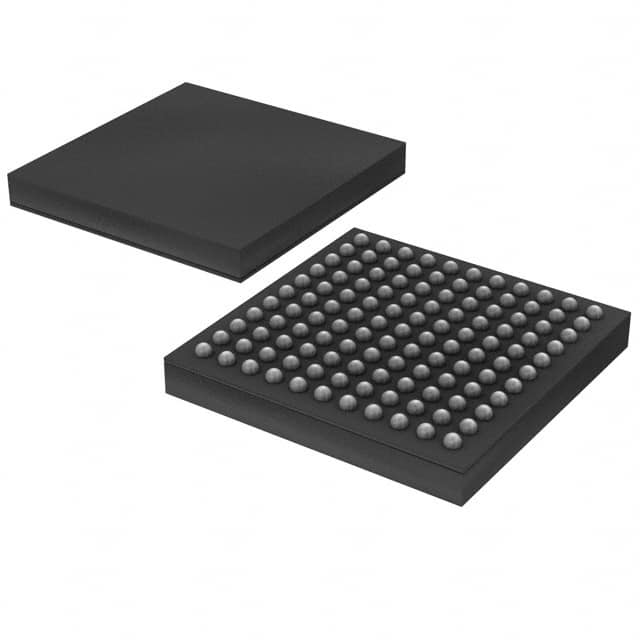EFM32LG295F128-BGA120
Product Overview
Category
The EFM32LG295F128-BGA120 belongs to the category of microcontrollers.
Use
This microcontroller is commonly used in various electronic devices and systems for controlling and processing data.
Characteristics
- High-performance 32-bit microcontroller
- Low power consumption
- Integrated peripherals for versatile applications
- Compact size and lightweight
- Robust and reliable design
Package
The EFM32LG295F128-BGA120 comes in a Ball Grid Array (BGA) package.
Essence
The essence of this microcontroller lies in its ability to provide efficient control and processing capabilities in a compact and low-power package.
Packaging/Quantity
The EFM32LG295F128-BGA120 is typically packaged individually and is available in various quantities depending on the manufacturer's specifications.
Specifications
- Microcontroller core: ARM Cortex-M3
- Clock speed: Up to 48 MHz
- Flash memory: 128 KB
- RAM: 16 KB
- Operating voltage: 1.8V - 3.6V
- Digital I/O pins: 120
- Analog inputs: 12
- Communication interfaces: UART, SPI, I2C, USB
- Timers: 4 general-purpose timers, 2 advanced timers
- ADC resolution: 12-bit
- Temperature range: -40°C to +85°C
Detailed Pin Configuration
The EFM32LG295F128-BGA120 has a total of 120 pins arranged in a specific configuration. The pinout diagram and detailed pin descriptions can be found in the product datasheet provided by the manufacturer.
Functional Features
- High-speed processing capabilities
- Low power consumption for energy-efficient operation
- Integrated peripherals for versatile applications
- Advanced communication interfaces for seamless connectivity
- Flexible I/O pins for interfacing with external devices
- Timers for precise timing control
- Analog inputs for sensor interfacing
- Built-in ADC for analog signal conversion
Advantages and Disadvantages
Advantages
- High-performance microcontroller suitable for demanding applications
- Low power consumption extends battery life in portable devices
- Versatile peripherals enable a wide range of applications
- Compact size allows for integration into space-constrained designs
- Robust design ensures reliable operation in various environments
Disadvantages
- Limited flash memory and RAM capacity compared to higher-end microcontrollers
- Higher cost compared to lower-end microcontrollers with similar specifications
- Requires knowledge of programming and microcontroller architecture for effective utilization
Working Principles
The EFM32LG295F128-BGA120 operates based on the ARM Cortex-M3 core architecture. It executes instructions stored in its flash memory, processes data, and controls various peripherals to perform specific tasks. The microcontroller communicates with external devices through its communication interfaces and interacts with the environment through its I/O pins.
Detailed Application Field Plans
The EFM32LG295F128-BGA120 finds applications in various fields, including but not limited to: - Industrial automation - Internet of Things (IoT) devices - Consumer electronics - Medical devices - Automotive systems - Home automation
Detailed and Complete Alternative Models
- EFM32GG995F1024-BGA112: Similar microcontroller with higher flash memory and RAM capacity.
- EFM32WG380F256-QFP100: Microcontroller with additional wireless connectivity options.
- EFM32ZG110F32-QFN32: Lower-cost microcontroller with reduced features but suitable for simpler applications.
These alternative models provide different specifications and features to cater to diverse application requirements.
Word count: 446 words
قم بإدراج 10 أسئلة وإجابات شائعة تتعلق بتطبيق EFM32LG295F128-BGA120 في الحلول التقنية
Sure! Here are 10 common questions and answers related to the application of EFM32LG295F128-BGA120 in technical solutions:
Q: What is EFM32LG295F128-BGA120? A: EFM32LG295F128-BGA120 is a microcontroller from Silicon Labs' EFM32 Leopard Gecko family, featuring an ARM Cortex-M3 core.
Q: What are the key features of EFM32LG295F128-BGA120? A: Some key features include 128KB Flash memory, 16KB RAM, 32-bit timers, UART, SPI, I2C interfaces, ADC, DAC, and low power consumption.
Q: What are the typical applications of EFM32LG295F128-BGA120? A: EFM32LG295F128-BGA120 is commonly used in various applications such as IoT devices, industrial automation, smart energy management, and consumer electronics.
Q: How can I program EFM32LG295F128-BGA120? A: You can program EFM32LG295F128-BGA120 using the Silicon Labs' Simplicity Studio IDE, which supports C programming language and provides a range of development tools.
Q: Can I use EFM32LG295F128-BGA120 for battery-powered applications? A: Yes, EFM32LG295F128-BGA120 is designed for low power consumption, making it suitable for battery-powered applications that require long battery life.
Q: Does EFM32LG295F128-BGA120 support communication protocols like Bluetooth or Wi-Fi? A: No, EFM32LG295F128-BGA120 does not have built-in Bluetooth or Wi-Fi capabilities. However, it can be used with external modules or ICs to enable wireless communication.
Q: What is the operating voltage range of EFM32LG295F128-BGA120? A: The operating voltage range of EFM32LG295F128-BGA120 is typically 1.8V to 3.8V.
Q: Can I interface EFM32LG295F128-BGA120 with sensors and actuators? A: Yes, EFM32LG295F128-BGA120 provides various digital and analog interfaces like GPIO, UART, SPI, I2C, ADC, and DAC, allowing you to interface with sensors and actuators.
Q: Is EFM32LG295F128-BGA120 suitable for real-time applications? A: Yes, EFM32LG295F128-BGA120's ARM Cortex-M3 core provides sufficient processing power and interrupt handling capabilities, making it suitable for real-time applications.
Q: Where can I find more information about EFM32LG295F128-BGA120? A: You can find more detailed information, including datasheets, reference manuals, and application notes, on Silicon Labs' official website or through their technical support channels.
Please note that the answers provided here are general and may vary depending on specific requirements and use cases.


